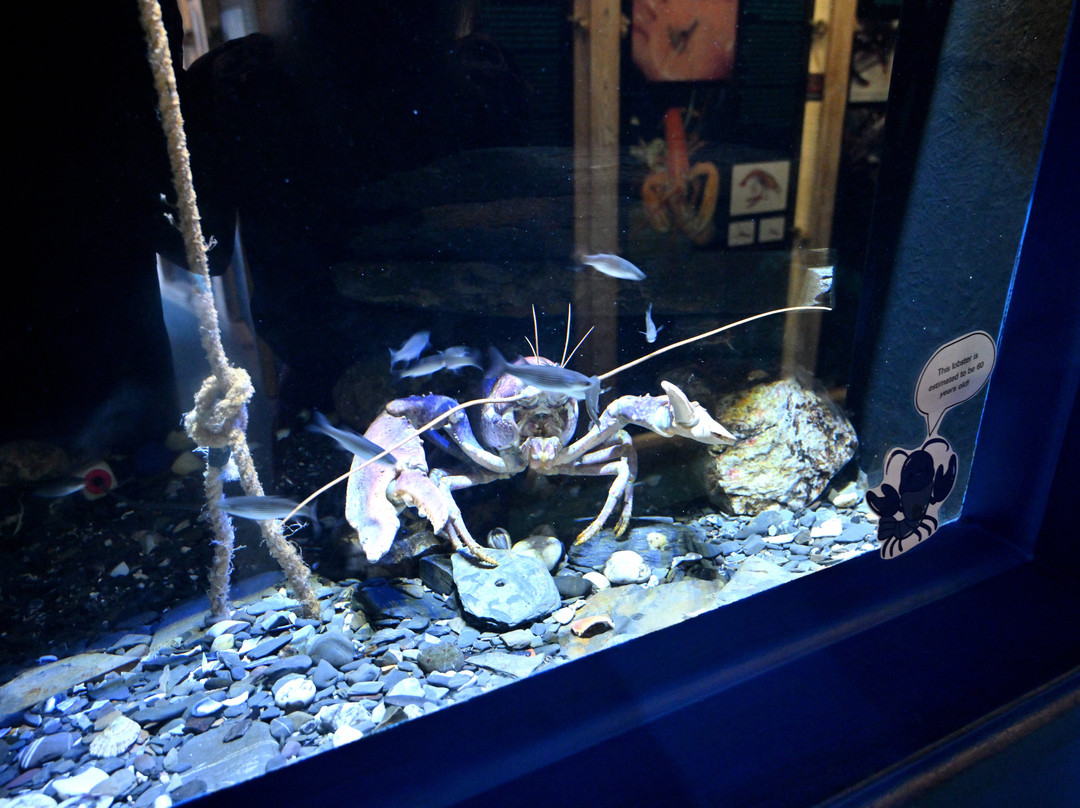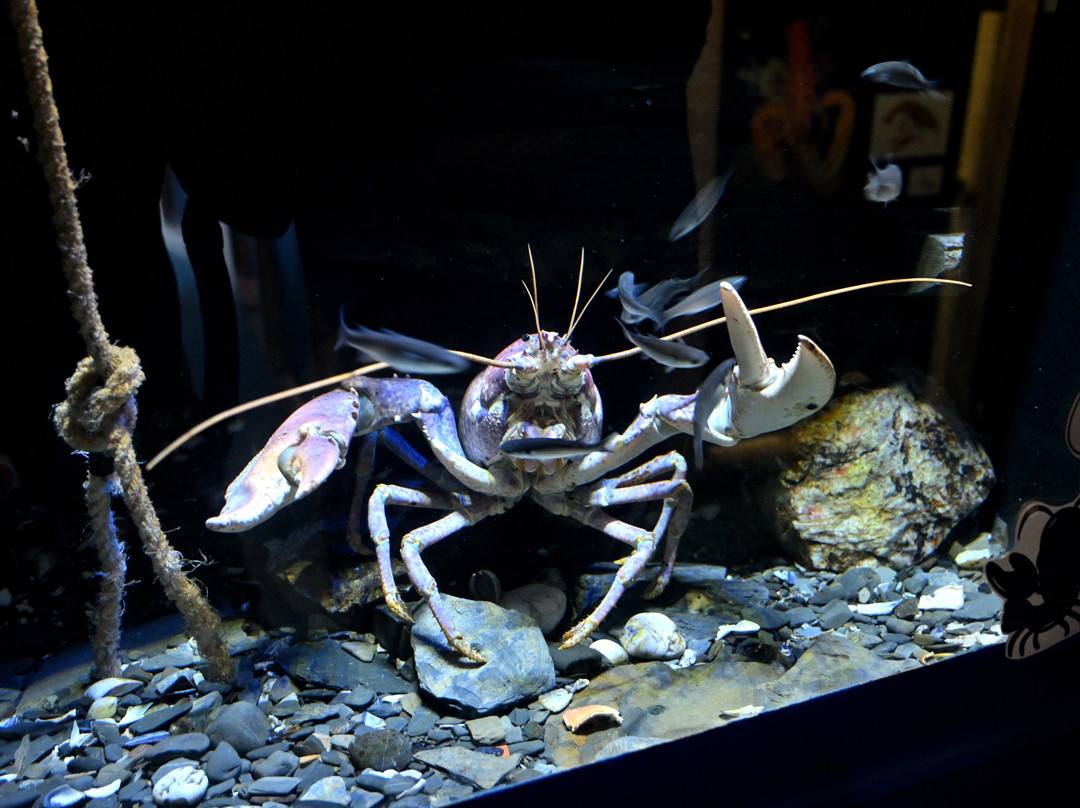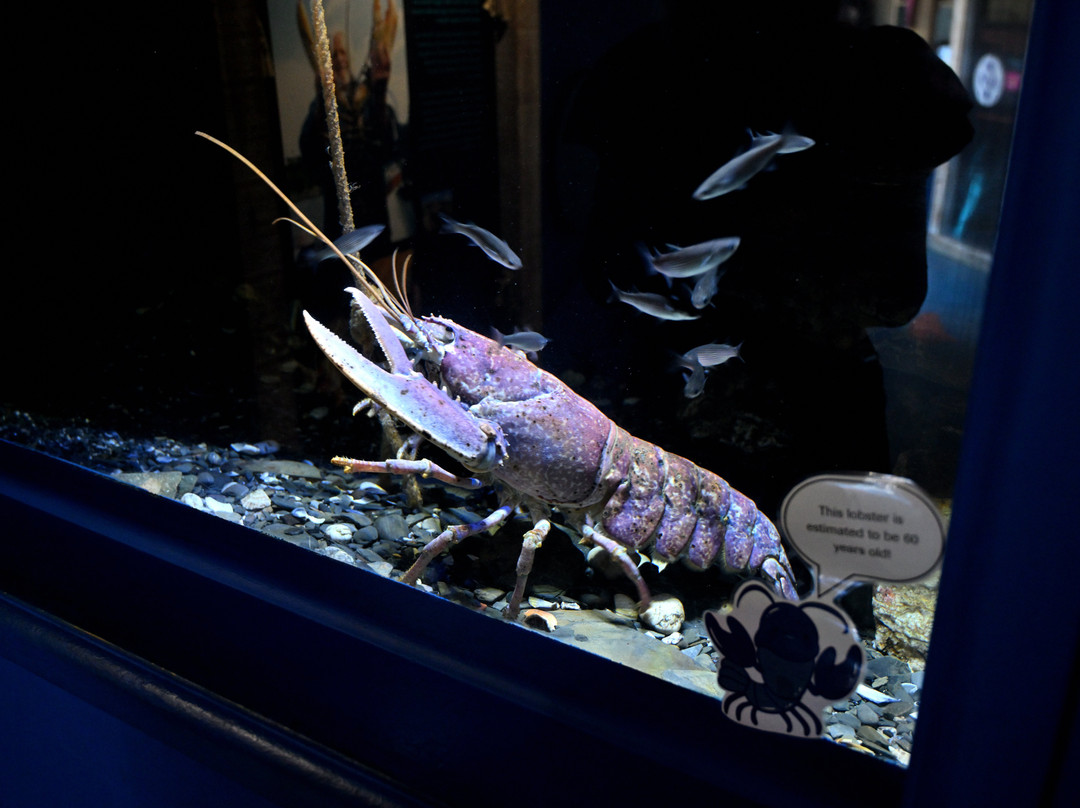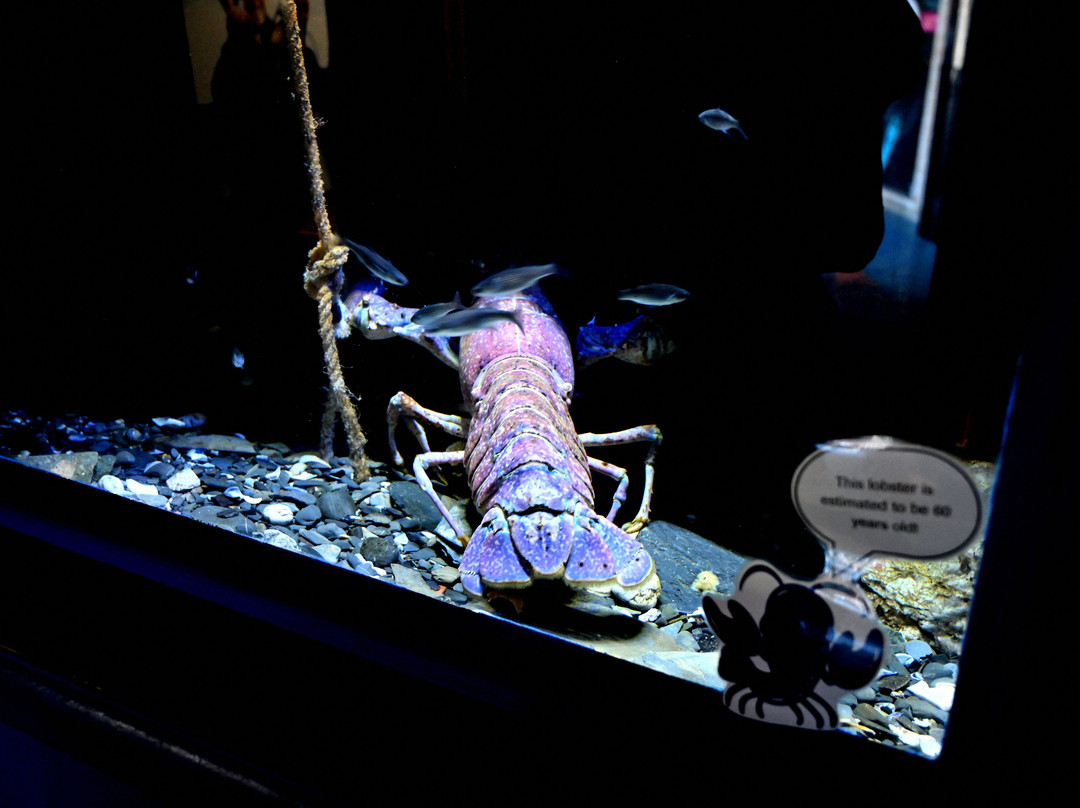的点评
An amazing charity dedicated to the survival of an iconic species
National Lobster Hatchery的点评
点评:When we found out about the National Lobster hatchery in Padstow it quickly went on to our list of places to visit.
From the out side it does not appear to be a large exhibit, but what happens inside is a gigantic leap in the preservation of this iconic species. Back in the 1960's my grandfather was already concerned with the over fishing of lobsters around the cornish coast as their popularity grew. He would have been very proud of what we saw in the hatchery.
When you walk in it is not a large area, there are Lobsters in tanks and information boards to help you understand. Then the large tank with cavities from tiles for the female lobsters to hide in. Then there is a tank with baby Lobsters in, circulating. Up stairs there is an area that children can learn about the local sea environment, whcih is also worth a visit.
Having walked through it felt a bit underwhelming. It was then we were asked by Malcolm if we wanted to know more about the work the charity does.
What followed was +/- 20 minutes of the most amazing story, that left us in awe of the work these volunteers do, in conjunction with local lobster fisherman.
The pregnant lobsters with around 20,000 eggs are brought to the hatchery by the local fishermen. At the hatchery they then check the stage of the pregnancy and place the Lobsters in the Maturity ward. This was the tank that we saw with the cavities. The Lobsters have to have their claws bound to stop the fighting which could result in the loos of the lobster and eggs. Once the eggs are close to hatching the lobster is moved to a seperate tank to wait the birth of 20,000 baby lobsters, who are then transferred to the circulating tank for the next stage of their development. The baby lobsters we saw in the tank were only a day or two old.
As a result of this intervention the survival rate of the baby lobsters has improved from 1 in 20,000 in the wild to 1000 in 20,000 as a result of the hatchery. Now making Lobster fishing a more sustainable industry.
It was also interesting to know that the biggest mortality rate of the baby lobsters is cannibalism at this stage.
The lobsters are then monitored at each stage of their development until they are ready to be reintroduced into the sea. This again enlists the help of the local fishermen, diving clubs and schools.
If you do visit then make sure you get the 20 minute talk from someone like Malcolm it really adds to the experience, with out it we would have left with only part of the story.
We made a donation and then adopted two lobsters bay lobsters who would be released later in the year. Which you can check up on online.
We saw and visited lots of places on our tour of Cornwall, but this must rate as one of the best.
From the out side it does not appear to be a large exhibit, but what happens inside is a gigantic leap in the preservation of this iconic species. Back in the 1960's my grandfather was already concerned with the over fishing of lobsters around the cornish coast as their popularity grew. He would have been very proud of what we saw in the hatchery.
When you walk in it is not a large area, there are Lobsters in tanks and information boards to help you understand. Then the large tank with cavities from tiles for the female lobsters to hide in. Then there is a tank with baby Lobsters in, circulating. Up stairs there is an area that children can learn about the local sea environment, whcih is also worth a visit.
Having walked through it felt a bit underwhelming. It was then we were asked by Malcolm if we wanted to know more about the work the charity does.
What followed was +/- 20 minutes of the most amazing story, that left us in awe of the work these volunteers do, in conjunction with local lobster fisherman.
The pregnant lobsters with around 20,000 eggs are brought to the hatchery by the local fishermen. At the hatchery they then check the stage of the pregnancy and place the Lobsters in the Maturity ward. This was the tank that we saw with the cavities. The Lobsters have to have their claws bound to stop the fighting which could result in the loos of the lobster and eggs. Once the eggs are close to hatching the lobster is moved to a seperate tank to wait the birth of 20,000 baby lobsters, who are then transferred to the circulating tank for the next stage of their development. The baby lobsters we saw in the tank were only a day or two old.
As a result of this intervention the survival rate of the baby lobsters has improved from 1 in 20,000 in the wild to 1000 in 20,000 as a result of the hatchery. Now making Lobster fishing a more sustainable industry.
It was also interesting to know that the biggest mortality rate of the baby lobsters is cannibalism at this stage.
The lobsters are then monitored at each stage of their development until they are ready to be reintroduced into the sea. This again enlists the help of the local fishermen, diving clubs and schools.
If you do visit then make sure you get the 20 minute talk from someone like Malcolm it really adds to the experience, with out it we would have left with only part of the story.
We made a donation and then adopted two lobsters bay lobsters who would be released later in the year. Which you can check up on online.
We saw and visited lots of places on our tour of Cornwall, but this must rate as one of the best.
翻译:当我们发现帕兹托的国家龙虾孵化场时,它很快就被列入了我们要去的地方名单。
从外面看,它似乎不是一个大型展览,但里面发生的事情是保护这一标志性物种的巨大飞跃。早在 20 世纪 60 年代,随着龙虾越来越受欢迎,我的祖父就已经担心康沃尔海岸附近过度捕捞龙虾的问题。他一定会为我们在孵化场看到的一切感到非常自豪。
当你走进去时,它并不是一个很大的区域,里面有龙虾在水箱里,还有信息板帮助你理解。然后是一个大水箱,里面有瓷砖做成的空腔,供雌龙虾躲藏。然后是一个水箱,里面有小龙虾在里面游动。楼上有一个区域,孩子们可以了解当地的海洋环境,也值得一游。
走过它感觉有点平淡无奇。就在那时,马尔科姆问我们是否想了解更多关于慈善机构的工作。
接下来是 +/- 20 分钟最令人惊奇的故事,让我们对这些志愿者与当地龙虾渔民合作所做的工作感到敬畏。
当地渔民将怀孕的龙虾和大约 20,000 颗龙虾卵带到孵化场。在孵化场,他们随后检查龙虾的怀孕阶段,并将龙虾放入成熟病房。这就是我们看到的有空洞的水箱。龙虾的爪子必须绑住,以防止打斗,否则可能会导致龙虾和卵的流失。一旦卵接近孵化,龙虾就会被转移到一个单独的水箱中,等待 20,000 只小龙虾的出生,然后将它们转移到循环水箱中,进行下一阶段的发育。我们在水箱中看到的小龙虾只有一两天大。
这项干预措施的结果是,由于孵化场的存在,小龙虾的存活率从野生状态下的 20,000 只中 1 只提高到了 20,000 只中 1000 只。现在,龙虾捕捞业已成为一个更具可持续性的行业。
有趣的是,小龙虾的最大死亡率是在这个阶段同类相食。
然后,对龙虾的每个发育阶段进行监测,直到它们准备好重新放归大海。这再次得到了当地渔民、潜水俱乐部和学校的帮助。
如果您确实要来参观,请务必听听 Malcolm 这样的人的 20 分钟讲座,这确实会为您带来更多体验,如果没有讲座,我们可能只了解了部分故事。
我们捐款,然后收养了两只龙虾湾龙虾,它们将于今年晚些时候被放归大海。您可以在线查看。
我们在康沃尔之旅中看到并参观了很多地方,但这个一定是最好的之一。
从外面看,它似乎不是一个大型展览,但里面发生的事情是保护这一标志性物种的巨大飞跃。早在 20 世纪 60 年代,随着龙虾越来越受欢迎,我的祖父就已经担心康沃尔海岸附近过度捕捞龙虾的问题。他一定会为我们在孵化场看到的一切感到非常自豪。
当你走进去时,它并不是一个很大的区域,里面有龙虾在水箱里,还有信息板帮助你理解。然后是一个大水箱,里面有瓷砖做成的空腔,供雌龙虾躲藏。然后是一个水箱,里面有小龙虾在里面游动。楼上有一个区域,孩子们可以了解当地的海洋环境,也值得一游。
走过它感觉有点平淡无奇。就在那时,马尔科姆问我们是否想了解更多关于慈善机构的工作。
接下来是 +/- 20 分钟最令人惊奇的故事,让我们对这些志愿者与当地龙虾渔民合作所做的工作感到敬畏。
当地渔民将怀孕的龙虾和大约 20,000 颗龙虾卵带到孵化场。在孵化场,他们随后检查龙虾的怀孕阶段,并将龙虾放入成熟病房。这就是我们看到的有空洞的水箱。龙虾的爪子必须绑住,以防止打斗,否则可能会导致龙虾和卵的流失。一旦卵接近孵化,龙虾就会被转移到一个单独的水箱中,等待 20,000 只小龙虾的出生,然后将它们转移到循环水箱中,进行下一阶段的发育。我们在水箱中看到的小龙虾只有一两天大。
这项干预措施的结果是,由于孵化场的存在,小龙虾的存活率从野生状态下的 20,000 只中 1 只提高到了 20,000 只中 1000 只。现在,龙虾捕捞业已成为一个更具可持续性的行业。
有趣的是,小龙虾的最大死亡率是在这个阶段同类相食。
然后,对龙虾的每个发育阶段进行监测,直到它们准备好重新放归大海。这再次得到了当地渔民、潜水俱乐部和学校的帮助。
如果您确实要来参观,请务必听听 Malcolm 这样的人的 20 分钟讲座,这确实会为您带来更多体验,如果没有讲座,我们可能只了解了部分故事。
我们捐款,然后收养了两只龙虾湾龙虾,它们将于今年晚些时候被放归大海。您可以在线查看。
我们在康沃尔之旅中看到并参观了很多地方,但这个一定是最好的之一。







此点评仅代表旅行者个人的主观意见,并不代表TripAdvisor以及其合作方的意见。
关于我们
|
新闻动态
|
商务合作
|
会员中心
|
业主中心
|
业主通
|
常见问题
|
意见反馈
|
联系我们
|
营业执照
© 2025 Tripadvisor 版权所有。
使用条款 |隐私政策 |网站工作原理
部分照片由 VFM Leonardo 提供。
* Tripadvisor不是旅行社,也不是旅游预订服务代理商。我们提供免费、客观、公正的旅游资讯服务。 (显示更多)
TripAdvisor LLC 既不是预订代理商,也不是旅游运营商,不会向网站用户收取任何服务费。 按照规定,在 Tripadvisor 发布机票价格、游览和旅行套餐的合作伙伴(航空公司、旅行提供商及预订代理商),其标价须包含所有费用和附加费用。 例如, 机场出入境税费、消费税与其他服务费、手续费、杂费及附加费用。 当您向我们的某个合作伙伴进行预订时,请务必查阅他们的网站以了解当地行政部门要求的所有适用费用的具体情况。 除非另有说明,机票价格通常指的是一个人的价格(以人民币计)。
为方便起见,TripAdvisor LLC 根据从我们的预订合作伙伴获取的空房率计算每个酒店的均价。 对于游览和景点来说,所显示价格通常是每位成人的最低可用价格。 对于列出的任何旅行套餐或优惠,TripAdvisor LLC 无法保证任何特定的费率或价格。 此外,酒店均价每晚会更新,并以您的首选币种表示(使用现行汇率)。 由于这些已换算的价格是预估价格,因此,有关具体金额和币种请与预订网站进行核实。
此外,TripAdvisor LLC 无法保证我们网站上宣传的价格随时有效。 标价可能需要预订一定天数才能生效,或有不可用日期、使用条件或限制。
TripAdvisor公司对外部网站的内容一概不负责。优惠价格中不含税和其他费用。
ICP证:沪B2-20200433
沪ICP备20013175号
 沪公网安备31010502005427号
沪公网安备31010502005427号鹰程信息技术(上海)有限公司
货币/国家及地区
¥CNY
中国

